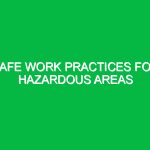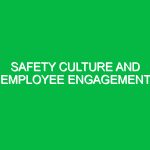Introduction
Emergency Response for Chemical Emergencies is a critical aspect of Health, Safety, and Environment (HSE) management. In our increasingly industrialized world, the potential for chemical spills, leaks, and other hazardous incidents looms large. Whether you’re in manufacturing, agriculture, or any sector handling chemicals, understanding the protocols for effective emergency response is essential. This knowledge not only safeguards lives but also minimizes environmental damage and financial loss.
Imagine a scenario where a chemical leak occurs in a bustling factory. Panic ensues as workers scramble to evacuate, but without a clear emergency response plan, the situation can escalate into chaos. This is why an organized and well-practiced emergency response procedure is vital. In this article, we will explore the various components of emergency response for chemical emergencies, the risks involved, safety precautions, best practices, and relevant regulations governing these situations.
Understanding the Hazards and Risks
The landscape of chemical emergencies is complex and fraught with danger. First, it is essential to identify the potential hazards associated with chemical substances. Chemicals can be categorized into various groups, each presenting unique risks. Flammables, corrosives, toxins, and reactives are just a few classifications. Each group requires specific handling and response strategies.
1. Types of Chemical Hazards
Flammable chemicals can ignite and cause fires or explosions. For instance, in 2018, a fire broke out at a chemical plant in Texas due to a flammable chemical leak, leading to injuries and significant property damage. Corrosive substances can cause severe skin burns and eye damage. An example is sulfuric acid, which can cause irreversible harm upon contact. Toxic chemicals can lead to serious health issues or even fatalities, as seen in the infamous Bhopal disaster of 1984, where a gas leak resulted in thousands of casualties.
2. Environmental Risks
Besides immediate health risks, chemical emergencies can have long-term environmental repercussions. Spills can contaminate soil and water sources, affecting local ecosystems and communities. For example, the Deepwater Horizon oil spill in 2010 highlighted the devastating effects of chemical leaks on marine life and coastal environments.
3. Human Factor Risks
Human error is another significant risk factor in chemical emergencies. Miscommunication, inadequate training, and lack of preparedness can exacerbate situations. A case study from a pharmaceutical company revealed that insufficient training led to a delayed response during a chemical spill, resulting in injuries among workers. This example underscores the importance of comprehensive training programs.
Safety Precautions and Best Practices
To minimize the risks associated with chemical emergencies, organizations must implement robust safety precautions and best practices. These strategies should encompass preparation, response, and recovery phases.
1. Preparation Strategies
Preparation is the cornerstone of effective emergency response. First and foremost, organizations must conduct thorough risk assessments to identify potential hazards within their operations. This involves cataloging all chemicals on-site and understanding their properties and potential risks. Regular drills and training sessions should be conducted to ensure all employees are familiar with emergency protocols.
Moreover, developing an Emergency Response Plan (ERP) is crucial. This plan should outline specific procedures for various types of chemical emergencies, detailing evacuation routes, communication protocols, and roles and responsibilities of team members. Regular updates and reviews of the ERP ensure its effectiveness and relevance.
2. Response Measures
In the event of a chemical emergency, swift and coordinated action is essential. Employees should be trained to recognize the signs of a chemical leak or spill. Immediate actions may include activating alarm systems, notifying emergency services, and initiating evacuation procedures.
Utilizing personal protective equipment (PPE) is critical during a chemical response. This may involve gloves, goggles, masks, and specialized suits. The choice of PPE should correspond to the chemical involved, as different substances require different levels of protection. For example, handling corrosive materials demands more robust protective gear than non-hazardous substances.
3. Recovery and Environmental Remediation
Recovery is as important as preparation and response. After a chemical emergency, organizations need to assess the impact and take appropriate measures to restore safety and compliance. This may involve decontaminating affected areas and ensuring that no residual chemicals pose a threat to health or the environment.
Environmental remediation can be a complex process. It often requires collaboration with environmental agencies and experts to ensure thorough cleanup and restoration of affected ecosystems. The lessons learned from the incident should feed back into the organization’s safety practices to prevent future occurrences.
Regulations and Standards Governing Chemical Emergency Response
Compliance with regulations is a non-negotiable aspect of emergency response for chemical emergencies. Various local, national, and international standards govern how organizations must prepare for and respond to chemical incidents.
1. OSHA Standards
The Occupational Safety and Health Administration (OSHA) provides guidelines for hazardous materials handling in the workplace. Their standards mandate that employers implement a Hazard Communication Program, ensuring that employees are informed about the chemicals they work with and the associated risks.
2. EPA Regulations
The Environmental Protection Agency (EPA) enforces regulations aimed at preventing chemical spills and ensuring proper reporting and cleanup procedures. The Clean Water Act and the Resource Conservation and Recovery Act are two key regulations that organizations must comply with to minimize environmental impacts from chemical emergencies.
3. NFPA Codes
The National Fire Protection Association (NFPA) establishes codes and standards related to fire safety that are particularly relevant in chemical emergency contexts. Their guidelines help organizations develop fire prevention strategies and emergency response protocols specifically tailored to flammable and reactive chemicals.
Conclusion
Emergency Response for Chemical Emergencies is an intricate but crucial aspect of HSE management. Understanding the potential hazards, implementing rigorous safety precautions, and adhering to relevant regulations can significantly mitigate risks. Companies must foster a culture of safety, where preparedness and training are prioritized. By doing so, they not only protect their employees and the environment but also enhance operational resilience in the face of unforeseen chemical incidents.
In the end, the goal is clear: to ensure that when a chemical emergency occurs, the response is swift, organized, and effective, minimizing harm and ensuring safety for all involved.


